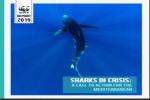Shark and ray conservation research
Shark and ray conservation research: Absent where the need is greatest Alec B.M. Moore, R. Dean Grubbs ABSTRACT: No abstract is available for this article. Aquatic Conservation, Early View Version, DOI: 10.1002/aqc.3192 SOURCE
Shark Fin Regulations in the United States
Shark Fin Regulations in the United States: Animal Welfare, Cultural, and Policy Considerations John Chung-En Liu, Brandon Gertz, Naomi Newman ABSTRACT: Sharks play critical roles in the marine ecosystem, and they face serious threats due to overfishing. Conservation efforts have focused on the consumption of shark fins, especially the “finning” practice that removes the fins
Element composition of shark vertebrae shows promise as a natural tag
Element composition of shark vertebrae shows promise as a natural tag J. C. A. Pistevos, P. Reis-Santos, C. Izzo, B. M. Gillanders ABSTRACT: Reconstructing movements and environmental histories of sharks may be possible by using the element composition of vertebrae, but unlocking such possibilities requires an understanding of the effects of extrinsic and intrinsic factors
Mesoscale eddies release pelagic sharks from thermal constraints
Mesoscale eddies release pelagic sharks from thermal constraints to foraging in the ocean twilight zone Camrin D. Braun, Peter Gaube, Tane H. Sinclair-Taylor, Gregory B. Skomal, and Simon R. Thorrold ABSTRACT: Mesoscale eddies are critical components of the ocean’s “internal weather” system. Mixing and stirring by eddies exerts significant control on biogeochemical fluxes in the
Reproductive biology, multiple paternity and polyandry of the bull shark
Reproductive biology, multiple paternity and polyandry of the bull shark Carcharhinus leucas Agathe Pirog, Hélène Magalon, Thomas Poirout, Sébastien Jaquemet ABSTRACT: To improve understanding of bull shark Carcharhinus leucas reproductive biology, we analysed reproductive traits from 118 bull sharks caught along Reunion Island coasts (Western Indian Ocean), including 16 gravid females. Specific microsatellite loci were
Bright Green Biofluorescence in Sharks Derives from Bromo-Kynurenine Metabolism
Bright Green Biofluorescence in Sharks Derives from Bromo-Kynurenine Metabolism Hyun Bong Park, Yick Chong Lam, Jean P.Gaffney, James C.Weaver, Sara Rose Krivoshik, Randy Hamchand, Vincent Pieribone, David F. Gruber, Jason M. Crawford ABSTRACT: Although in recent years there has been an increased awareness of the widespread nature of biofluorescence in the marine environment, the diversity
Global diet analysis of 23 species of chondrichthyes
Feeding together: a global diet analysis of twenty-three species of chondrichthyes on a feeding ground area Mauro Belleggia, Cristian Battagliotti, Federico Cortés, Jorge Horacio Colonello ABSTRACT: A global analysis of the diet of chondrichthyes (23 species) was conducted during one bottom-trawl research cruise in the region where the highest catches of skates occurred off southwestern
Environmental characteristics associated with the presence of the Spinetail devil ray in the eastern tropical Pacific
Environmental characteristics associated with the presence of the Spinetail devil ray (Mobula mobular) in the eastern tropical Pacific Nerea Lezama-Ochoa, Martin A. Hall, Maria Grazia Pennino, Joshua D. Stewart, Jon López, Hilario Murua ABSTRACT: In the eastern Pacific Ocean, the tropical tuna purse-seine fishery incidentally captures high numbers of five mobulid bycatch species; all of
Remote reefs and seamounts are the last refuges for marine predators
Remote reefs and seamounts are the last refuges for marine predators across the Indo-Pacific Tom B. Letessier, David Mouillot, Phil J. Bouchet, Laurent Vigliola, Marjorie C. Fernandes, Chris Thompson, Germain Boussarie, Jemma Turner, Jean-Baptiste Juhel, Eva Maire, M. Julian Caley, Heather J. Koldewey, Alan Friedlander, Enric Sala, Jessica J. Meeuwig ABSTRACT: Since the 1950s, industrial
The Energetics of Shark and Ray Megafauna
Powering Ocean Giants: The Energetics of Shark and Ray Megafauna Christopher L. Lawson, Lewis G. Halsey, Graeme C. Hays, Christine L. Dudgeon, Nicholas L. Payne, Michael B. Bennett, Craig R. White, Anthony J. Richardson ABSTRACT: Shark and ray megafauna have crucial roles as top predators in many marine ecosystems, but are currently among the most
Acoustic accelerometry reveals diel activity patterns in premigratory Port Jackson sharks
Acoustic accelerometry reveals diel activity patterns in premigratory Port Jackson sharks Julianna Kadar, Monique Ladds, Johann Mourier, Joanna Day, Culum Brown ABSTRACT: Distinguishing the factors that influence activity within a species advances understanding of their behavior and ecology. Continuous observation in the marine environment is not feasible but biotelemetry devices provide an opportunity for detailed
Global spatial risk assessment of sharks
Global spatial risk assessment of sharks under the footprint of fisheries Nuno Queiroz, Nicolas E. Humphries, David W. Sims, et al. ABSTRACT: Effective ocean management and conservation of highly migratory species depends on resolving overlap between animal movements and distributions and fishing effort. Yet, this information is lacking at a global scale. Here we show,
Seasonal trends in whale shark sightings in an established tourism site
Seasonal trends in whale shark Rhincodon typus sightings in an established tourism site in the Gulf of California, Mexico D. A. Whitehead, D. Petatán‐Ramírez, D. Olivier, R. González Armas, F. Pancaldi, F. Galván‐Magaña ABSTRACT: The number of individual whale shark Rhincodon typus sightings registered October 2015–March 2018 in Bahia de La Paz, Mexico, ranged from
WWF Report: Sharks in the Mediterranean Sea 2019
Sharks In Crisis: A Call To Action For The Mediterranean Published in July 2019 by WWF PDF-DOWNLOAD
Shark and ray entanglement in anthropogenic marine debris
Global review of shark and ray entanglement in anthropogenic marine debris Kristian J. Parton, Tamara S. Galloway, Brendan J. Godley ABSTRACT: Numerous marine taxa become entangled in anthropogenic marine debris, including cartilaginous fishes (class: Chondrichthyes, e.g. elasmobranchs , holocephalans ). Here we review research that has been conducted on the susceptibility of




